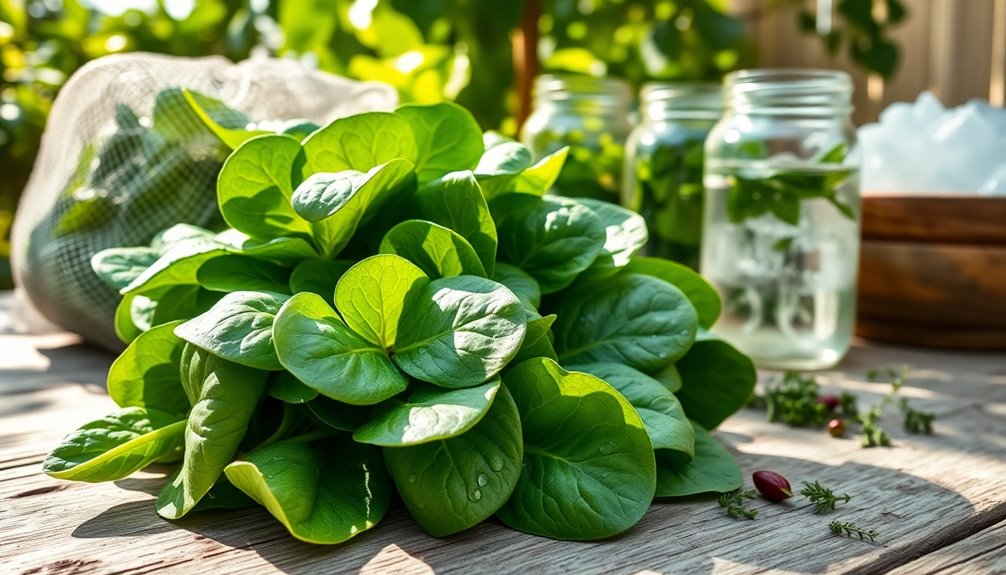To preserve spinach for long-term storage, you can use blanching and freezing, or dehydrating methods. Blanch spinach briefly in boiling water, then freeze it in airtight bags. For dehydrating, use a dehydrator or oven to remove moisture from the leaves. Store in a cool, dark place afterward. You can also vacuum pack to extend shelf life. These methods keep nutrients intact and prevent spoilage. Discover more techniques and tips to maximize freshness.
Key Takeaways
- Blanch spinach for 1-2 minutes, cool in ice water, and freeze in airtight bags for nutrient preservation up to a year.
- Dehydrate spinach at 95°F to 125°F for 4-10 hours for long-term storage, maintaining flavor and nutrients.
- Store fresh spinach in breathable containers in the fridge, avoiding washing until use to extend shelf life.
- Vacuum packing can extend spinach shelf life up to 14 days, offering a convenient preservation method.
- Melatonin treatment can enhance spinach shelf life but may involve additional costs for implementation.
Freshness and Shelf Life of Spinach
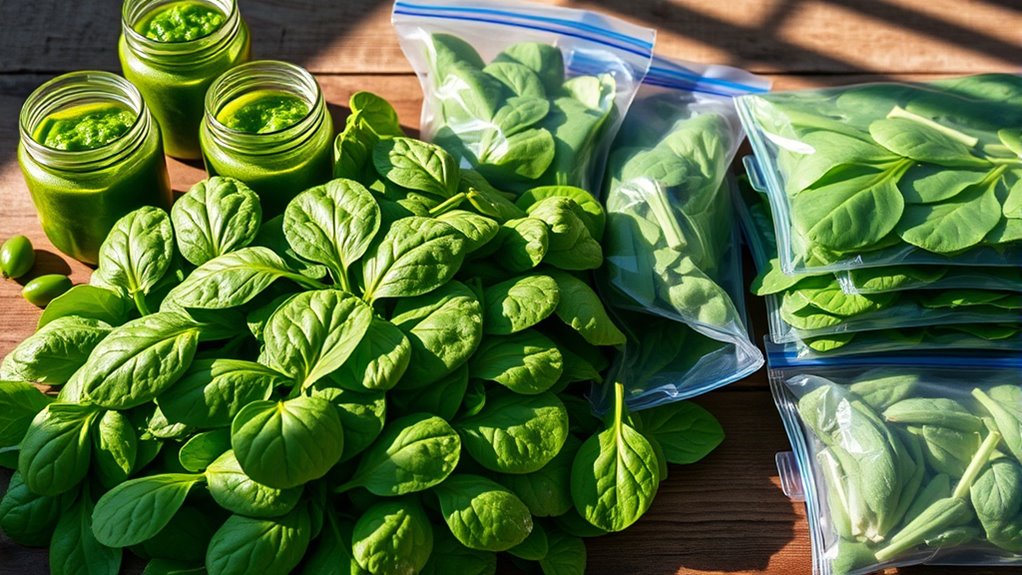
When you store spinach, its freshness and shelf life hinge on several key factors.
First, keep it at a consistent, cold temperature to slow decay. Moderate humidity is also crucial; it keeps spinach hydrated without making it soggy. Proper packaging protects the leaves from air and moisture, which can accelerate spoilage.
The initial freshness at purchase plays a significant role in how long it lasts. Whole leaves can last 5-7 days in an unopened bag, while opened containers typically last 3-5 days. Chopped spinach has a shorter shelf life of just 1-2 days.
Proper Storage Techniques for Fresh Spinach
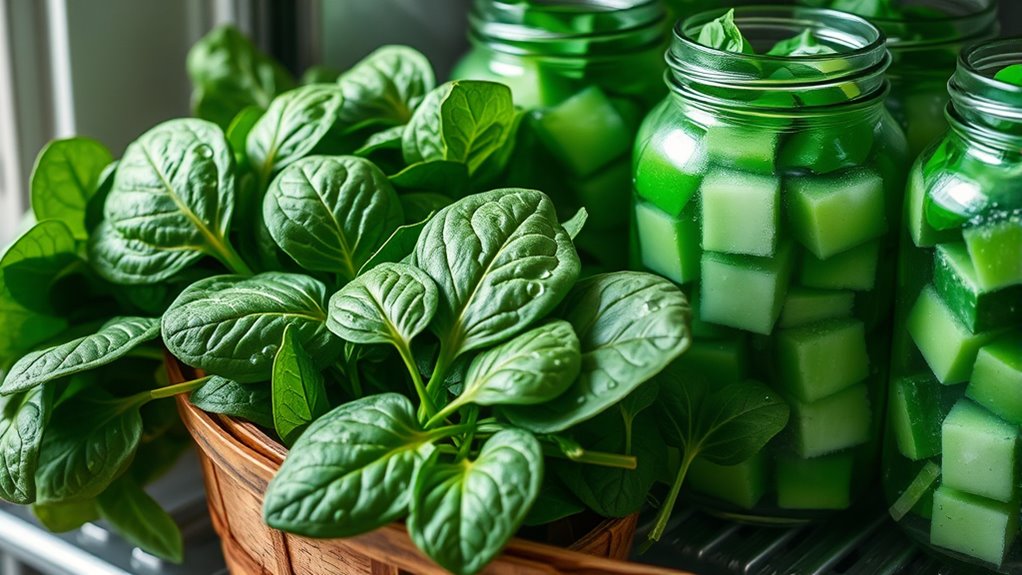
To keep your spinach fresh for as long as possible, implementing proper storage techniques is key.
Start by sorting through your spinach, discarding any yellow or wilted leaves. Avoid washing it until you're ready to use it, as excess moisture promotes spoilage. Instead, pat the spinach dry and store it in breathable containers like perforated bags or those lined with paper towels to absorb moisture.
Place the container in the crisper drawer of your fridge for optimal temperature control. Regularly check for spoilage, ensuring you remove any bad leaves.
You can also layer spinach with slices of bread or dry paper towels to further absorb moisture and extend its shelf life.
Blanching and Freezing Spinach
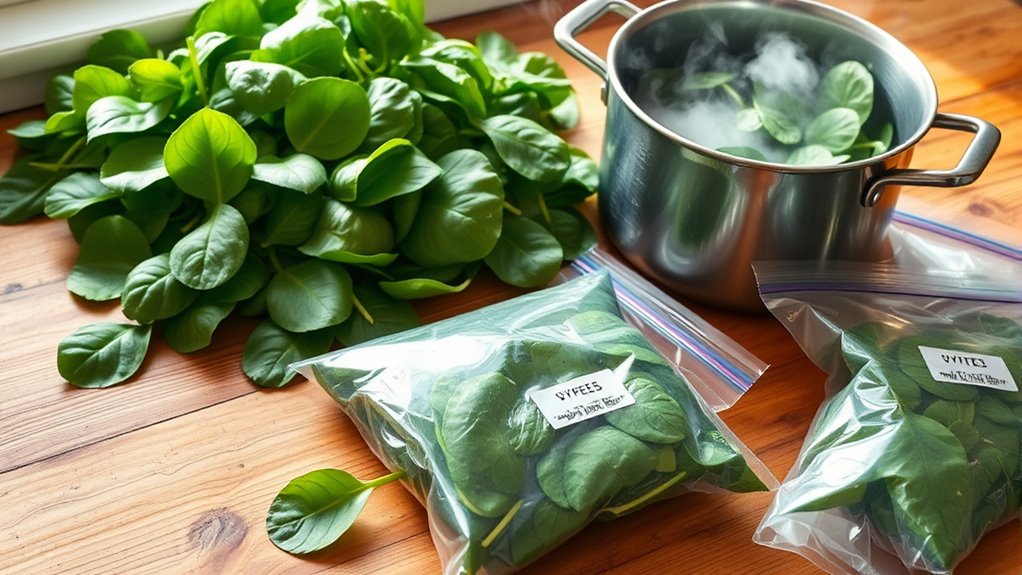
Blanching and freezing spinach is a simple process that preserves its flavor, color, and nutrients, making it a great option for enjoying this leafy green year-round.
Start by washing the spinach thoroughly to remove any dirt, then remove large stems. Blanch the spinach in boiling water for 1 to 2 minutes, ensuring you do this in batches to avoid overcrowding.
Wash spinach thoroughly to remove dirt, then trim large stems. Blanch in boiling water for 1 to 2 minutes in batches.
Immediately cool the blanched spinach in ice water to stop the cooking process. Once cooled, drain and portion the spinach into airtight freezer bags or ice cube trays.
Label each bag with the date. Properly frozen, spinach can last up to a year, ready for use in soups, smoothies, casseroles, and more!
The Dehydration Process for Spinach

Dehydrating spinach is a fantastic way to preserve its nutrients and flavor, ensuring you can enjoy this leafy green long after its harvest. Start by washing the spinach thoroughly to remove any dirt, then shake off excess water or use a salad spinner.
Remove large stems and select only fresh, unblemished leaves. You can chop the leaves for easier grinding later if you'd like.
For the best results, use a dehydrator set between 95°F to 125°F, drying for 4 to 10 hours. Arrange the leaves in a single layer and rotate trays for even drying.
Alternatively, you can use an oven on the lowest setting, ensuring airflow by keeping the door ajar. Monitor closely to prevent burning.
Tips for Extending Shelf Life
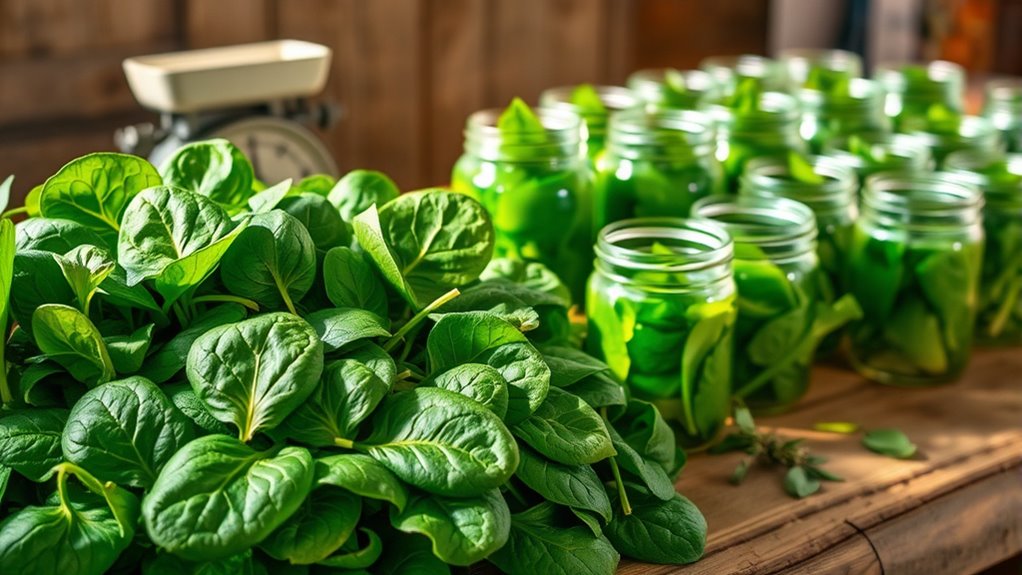
Once you've successfully dehydrated spinach, storing it properly is key to maximizing its shelf life.
First, avoid excess moisture by keeping spinach unwashed until you're ready to use it. Use breathable containers or bags with ventilation holes to promote airflow and prevent moisture buildup.
Store your spinach in the crisper drawer of the refrigerator, where temperatures are consistent and slightly humid. To absorb any moisture, place paper towels in the container.
Regularly check for yellow or brown discoloration and remove damaged leaves to maintain freshness. You might also layer spinach with slices of bread or use LDPE bags for added moisture control.
Comparison of Preservation Methods
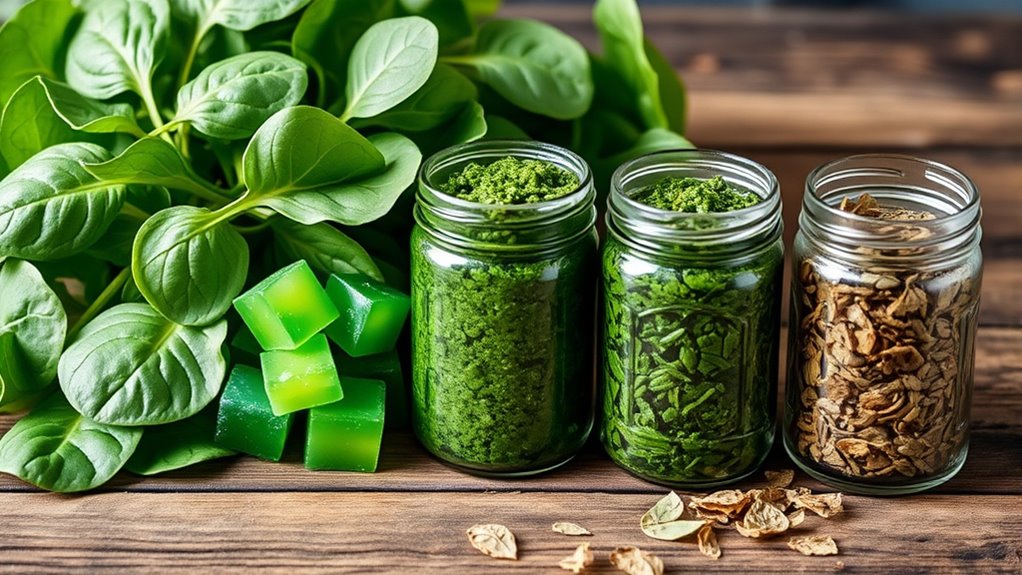
When considering how to preserve spinach, it's essential to weigh the pros and cons of various methods.
Vacuum packing is economical and convenient, extending shelf life up to 14 days, while modified atmosphere packing offers longer preservation but at a higher cost.
Blanching and freezing are cost-effective and preserve nutrients for several months, making them a popular choice.
Dehydrating allows for long-term storage but may require a dehydrator as an initial investment.
Lastly, melatonin treatment enhances shelf life by delaying chlorophyll degradation but can add extra costs.
Each method has its unique advantages and considerations, so think about your storage needs and budget to choose the best option for you.
Nutritional Benefits of Preserved Spinach

Although fresh spinach is often praised for its nutritional benefits, preserved spinach offers a wealth of advantages that shouldn't be overlooked.
Preserved spinach delivers essential nutrients and health benefits year-round, making it a valuable addition to your diet.
When you choose preserved spinach, you're still getting essential vitamins A, C, and K, which support your immune function and bone health. It's also a great source of iron and potassium, helping with blood health and maintaining healthy blood pressure.
The antioxidants in preserved spinach, like lutein and zeaxanthin, protect your eye health. Plus, with its high fiber content, you'll promote good digestive health and regular bowel movements.
Don't forget, it even adds a protein boost to your diet, supporting muscle health effectively. Embracing preserved spinach means enjoying these benefits year-round!
Creative Ways to Use Stored Spinach

If you're looking to elevate your meals, incorporating stored spinach can be a game changer.
Try adding frozen spinach to quiches or frittatas for a nutritious breakfast. For a fun snack, whip up spinach and artichoke pretzels or spinach-stuffed mushrooms.
Blend it into smoothies for an earthy boost or mix it into pasta sauces and soups for added flavor.
Don't forget about savory options like spinach and cheese quesadillas or meatballs.
You can even sneak it into baked goods like muffins or scones for a healthy twist.
With so many creative uses, stored spinach can transform your cooking and help you enjoy its nutritional benefits year-round.
Frequently Asked Questions
Can I Store Spinach at Room Temperature?
You can store spinach at room temperature for a short time, but it's risky.
If it gets wet, it'll spoil quickly, especially in warmer temperatures. To keep it fresh for a few hours, make sure it's dry and out of direct sunlight.
However, for longer storage, you'll want to refrigerate or freeze it to maintain its freshness and nutrients. Room temperature isn't suitable for keeping spinach good for long!
How Can I Tell if Spinach Has Gone Bad?
To tell if spinach has gone bad, check for visual signs first. Look for yellowing leaves, slimy texture, or significant wilting.
Discoloration, like dark spots, also indicates spoilage. Trust your nose too; spoiled spinach has a strong, musty odor. If it smells off, it's best to toss it.
Regularly inspect your spinach to ensure it stays fresh and safe to eat, helping you avoid any unpleasant surprises.
Is It Safe to Eat Spinach After Freezing?
Did you know that about 48 million people get sick from foodborne illnesses each year in the U.S.?
When it comes to frozen spinach, it's generally safe to eat, as long as you handle it properly. Ensure you cook it thoroughly to eliminate any potential pathogens.
If you follow safe storage practices, you can enjoy its nutritional benefits while minimizing health risks. Just remember, proper cooking is key for safety!
Can I Mix Fresh and Frozen Spinach Together?
Yes, you can mix fresh and frozen spinach together!
Just remember that fresh spinach retains its crispness, while frozen spinach becomes softer when thawed. This difference in texture might affect your dish, but if you're using them in smoothies or cooked meals, it shouldn't be a problem.
Make sure to thaw the frozen spinach first to ensure even mixing and distribution.
Enjoy the nutritional benefits from both forms!
How Do I Rehydrate Dried Spinach for Cooking?
To rehydrate dried spinach for cooking, start by placing it in a bowl and covering it with boiling water.
Let it soak for about 5 to 15 minutes, depending on your preference. For every cup of dried spinach, use about one cup of water.
Gently stir to ensure even rehydration. Once it's plump and tender, drain any excess water, and it's ready to enhance your dishes like soups or smoothies!
Conclusion
In the quest to preserve spinach, you're not just extending its shelf life; you're holding onto the vibrant nutrients and flavors that nourish your body. By choosing the right storage methods, you're ensuring that every bite remains a burst of health, even months later. Just imagine reaching for a bag of frozen spinach in winter, knowing it still carries the essence of summer's harvest. That's not just practicality; it's a way to keep your meals fresh and your spirit bright.





